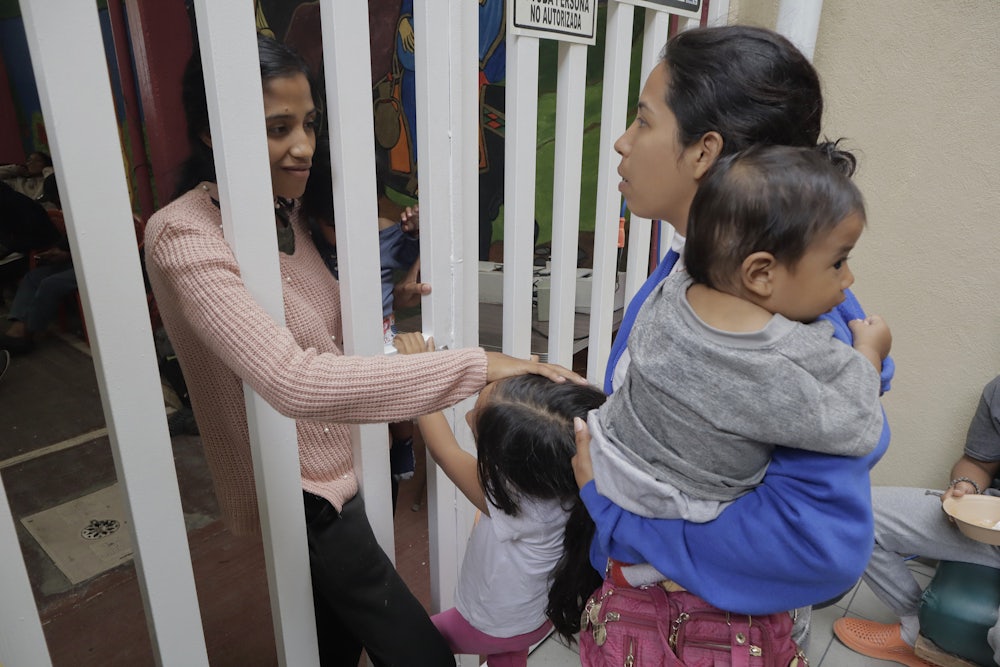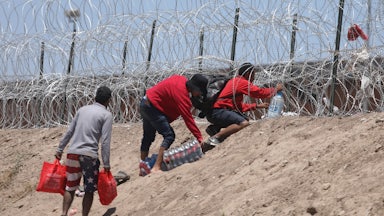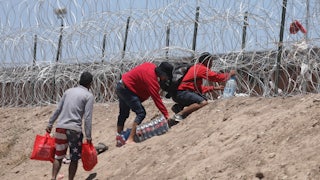The Cafemín migrant shelter, in the northern neighborhood of Vallejo in Mexico City, is at 700 percent capacity. A sign in the window drawn in permanent marker tells the story to those on the street: “Sorry, no space available.” Still, a line has formed all the same. The men waiting outside lift the backs of their tee-shirts over their heads to shield themselves from an anticipated downpour, turning their heads expectantly anytime someone opens the metal door.
“Three hundred leave one weekend, and another three hundred immediately come in to replace them,” said Sam, an interminably busy woman who serves as one of the shelter’s administrators. Most of the residents hang out in an expansive courtyard with a curved metal roof. It’s the middle of the rainy season, and the left side of the space has begun to flood. The door to the courtyard is locked and guarded, to prevent the dozens of small children who run and hide in between the plastic tables and chairs from escaping into the city.
Most of Cafemín’s residents are families with young children from Venezuela, Central America, or the Caribbean—weary from weeks on the road, living out of small backpacks and sleeping on thin blankets on the floor. Most are only several days away from the finish line of their journey at the U.S. border. There, they will attempt to maneuver themselves into an “encounter” with Border Patrol, ask for asylum, and begin new lives with greater safety and greater economic opportunity, as over a million people have done in the past year.
But some at Cafemín are part of a new class of migrants—those who already made it to the border but were rejected by U.S. authorities and shipped back to Southern Mexico in unmarked buses, where they now process the shock of their defeat. Their situation resembles a high-stakes board game in which unfortunate players are kicked back to the starting tile, all their money lost. These unlucky souls have come to be called migrantes devueltos, or “returned” migrants.
“I don’t know how many there are with this story, but every week, more of them show up,” Sam said. The U.S. government listed the number of migrants officially “returned” to Mexico between May and July as 4,000, but the real figure could be closer to 25,000.
It all begins with an unassuming phone call. Since May, U.S. authorities have begun using telephone interviews with increasing frequency to screen incoming migrants for base-level asylum eligibility. In-person screening demands personnel and time, both in short supply, as hundreds are processed at the border daily. Those who pass the test are required to prove their need for U.S. government protection to a judge, but assigned court dates stretch all the way to 2029. In the minds of most migrants, it really only matters that you make a good first impression.
The outcomes of those who pass the interview, some of whom find themselves getting looped into one of Ron DeSantis’s stunt flights to Sacramento or joining a fleet of newcomers selling candy on New York City subways, have been well documented in the American media. Little attention has been given to those who fail and get kicked back to square one.
Title 42, a pandemic-era immigration law, used a public health rationale to allow authorities to expel migrants to Mexico without giving them the opportunity to ask for asylum. It was used three million times by Border Patrol starting in 2020. The law expired this May, and now officials must keep migrants in U.S. custody and decide, legally within three days, who deserves protection and who should be expelled—thus, the introduction of the short, simple telephone interview. Despite the legal limit of 72 hours, many migrants are held in custody for several weeks to complete this process.
These fate-determining phone interviews often last only 15 minutes—a scant amount of time to contemplate the entire history of a person and decide whether they should reside above or below the Rio Grande. “I was led into a little phone booth and told I would need to answer some questions. I had no idea what was happening. I had no idea it mattered,” Luís Manuel Ramirez, a migrant from Venezuela who failed the interview, said. “It’s unjust—a trial without lawyers or a real judge.”
In the interview, the asylum officer must determine whether the migrant expresses “credible fear,” both of returning to their home country and of being left in Mexico, which is where the migrant will be dropped off if they fail the interview. Back in May, the Mexican government agreed to take in 30,000 rejectees each month from Venezuela, Nicaragua, Haiti, and Cuba, with the expectation that they would apply for asylum in Mexico. This was a convenient deal to evade the steep costs of deportation flights, in return for the United States accepting the same number each month through a humanitarian parole program.
The new system means the U.S. is urging vulnerable populations to apply for protection in Mexico instead, a country where the U.S. tells its own citizens to exercise “extreme caution” when traveling, due to high levels of violence.
Most migrants are not experts in immigration law; many need to flee their homes with immediate haste just for survival and do not have time to wait for approval in the parole program or to read the fine print explaining intergovernmental deals. What intel they receive about the process comes to them anecdotally, through family, friends, and groups on social media. Many are not aware that to enter the U.S., they now need to prove they are escaping something truly terrifying, not only in their home countries but in Mexico as well.
“No one told me there would be an interview; no one told me about—what is it called? Credible fear? Yeah, my daughter didn’t tell me, so I didn’t know there were specific things I should say,” Carmen Higuera, a 49-year-old Venezuelan migrant who failed the interview, said.
“I would never lie to an official, so I just told the truth, that I had not been assaulted or threatened in Mexico.” U.S. officials took this to mean she could be sent back to Mexico without any problem and did not need the protection of the U.S. She was deemed unfit for asylum.
Higuera was handcuffed and marched into a van where Mexican authorities from the National Migration Institute were waiting. The van drove her back over a border checkpoint into Coahuila, Mexico. From there, she and a group of other migrants in the same situation were loaded onto an unmarked bus. No one knew where the bus was headed or for how long they would be aboard.
One day and over a thousand miles later, they arrived in Villahermosa, in the Southern Mexican state of Tabasco. Those who had $80 readily available transferred buses and reversed their journeys halfway, another 12 hours to Mexico City, to try and get just a few hundred miles closer to the border and to the dreams they were forced to abandon.
Forced to leave most of her things in the dust when she was processed by Border Patrol in Piedras Negras, Higuera’s only belongings were the clothes on her back, her passport, and her cell phone. It was the first time she was a free woman in 22 days, but it felt more like exile. And for the first time, she was alone.
On the migrant trail in May, Higuera survived deadly flooding in the Darien jungle between Colombia and Panama, robbery, and hunger, melding into one mind with her 24-year-old daughter, both determined to keep her daughter’s two toddlers alive through the journey. Weeks later, in U.S. custody, her daughter and the two girls were treated as a family unit, but Higuera ended up being classified as a separate, single adult. “The United States only recognizes the immediate, nuclear family,” said Adam Isacson, policy director at the Washington Office on Latin America. “The result of the interview can also be pretty arbitrary—it definitely matters who your asylum officer is.”
“I showed them my phone, where my daughter’s number was in a family group chat, but they didn’t listen to me,” Higuera said.
Higuera’s daughter and grandchildren passed the credible fear interview and arrived in Chicago several days later, where they are living in a shelter. Now Higuera is a family of one, sitting slumped at a table in Cafemín’s courtyard, in her well-worn yellow sweater, praying for a miracle.
Over the course of the past four months, as the asylum interviews transitioned to the telephone model, their pass rate has dipped from 83 percent to 60 percent, with periods when it has been as low as 48 percent. Thousands have been returned to Mexican custody after failure to express credible fear, and shipped hundreds of miles away from the border, where most are stuck penniless in unfamiliar Mexican cities, left to contemplate their next moves.
Though the Mexican government claims the migrants are shipped south to ease pressure on border towns, shelters in Mexico City are overflowing, while those in border cities like Juárez reported rows of empty beds through the summer.
“They’re being very untransparent about the number of people sent back to Mexico, because the Mexican government doesn’t want it to get out. They send them to the interior of the country partly because they want to make the experience difficult, because they believe in deterrence, the same way the United States does,” Isacson said.
In this way, “returned” migrants have become pawns; stuck in Southern Mexico with empty pockets, they serve as a warning of possible frightening consequences to the rest of the migrant population, in an attempt to convince people not to attempt the journey. They also serve as evidence that the Biden administration is “handling” the border.
“If it gets out in the migrant community that you can get released very easily into the States, you’ll have full Border Patrol stations, and then Fox News B-roll footage of a ‘crisis’ at the border just before the election. There are strong political imperatives—no one gets reelected because they’re kind to migrants,” Isacson said.
Unsurprisingly, these policies of deterrence have so far proven to be ineffective. According to Panamanian authorities, August was the busiest month ever recorded for migrants crossing the Darien Gap on their way to the border.
“Returned migrants” face daunting obstacles. Since Title 42 expired, an older law, Title 8, now reigns, and it contains a poison pill: Any migrant who crosses the border “illegally” is banned from entry into the U.S. for five years. Technically, most asylum-seekers cross “illegally” by waiting near gates in the wall for Border Patrol to arrive.
In practice, the rule means that “returned” migrants cannot simply show up at the wall and try to redo the whole process. Additionally, any “returned” migrant who pays a smuggler to get over the border and is caught by U.S. authorities could face jail time. These migrants’ only hope for a second chance is a faulty smartphone app.
Some of the “returned” migrants have managed to secure coveted appointments on the Border Patrol’s new app, called CBPOne, which boasts a streamlining of the migration process by offering 1,450 slots per day for migrants to meet with officers at the border and turn themselves in for asylum screening. In the first half of the year, migrants were met with frustrating technical glitches while using the app and extremely high demand for appointments. The new system also puts migrants who do not own a cell phone, or who have lost their phone along the journey, at an extreme disadvantage.
“CBPOne actually makes it easier for agencies to know exactly who they’re dealing with every day and assign agents to that, rather than having to spring into action on the fly to meet a group of 500 people somewhere at the wall. It also lets migrants avoid being sent to detention centers, and they can keep more of their property with them, but you do have to wait and get an appointment,” said Aaron Reichlin-Melnick, policy director for the Immigration Council.
But records of their failed interviews will mean “returned” migrants will need to meet an even higher standard of credible fear in their CBPOne meetings with Border Patrol agents. They’ll also need to scrape together enough plata to make it back to the border from wherever they are stranded in Mexico.
Carmen Higuera has run out of money, after four months in Mexico City, a place she never intended to spend more than a few days in her life. She needs 2,400 Mexican pesos, about $140, for a flight to the border, so she can make her CBPOne appointment. She would take a bus, but she’s worried about the high rates of extortion and kidnapping for ransom in Northern Mexico right now. Certain bus companies in northern cities have also begun to refuse tickets to migrants.
There’s another hurdle on top of these: For Higuera to make it to Chicago, her daughter needs to find work to provide the money, but she has yet to receive American work authorization.
Facing tragic odds, some “returned” migrants apply for refugee status in Mexico and turn their eyes reluctantly toward the possibility of building a life there. So far this year, Mexico has seen a 30 percent rise in asylum applications. “But I never planned to live in Mexico,” said Yuli, a Venezuelan woman in her forties who was “returned” in July.
Yuli has Colombian citizenship through her mother and says she believes she failed the asylum interview because she gave an unsatisfactory answer when asked why she did not settle in Colombia. “I told them I had no family in Colombia, only in the United States.” Yuli fled Maracaibo, Venezuela, after receiving death threats from members of a corrupt police force.
Now she is hoping to return to Colombia, rather than try her luck with CBPOne or settle in Mexico. Living with a physical disability—poor mobility and pain in her joints, exacerbated by all of the walking she’s done this year—she’s not sure whether her body can handle another trip up to the border. The only issue: Having saved up only enough cash for her original journey, she does not have the money for a return flight to Bogotá—or anywhere else. “I’m too old for this,” she said. “I’m completely exhausted.”










